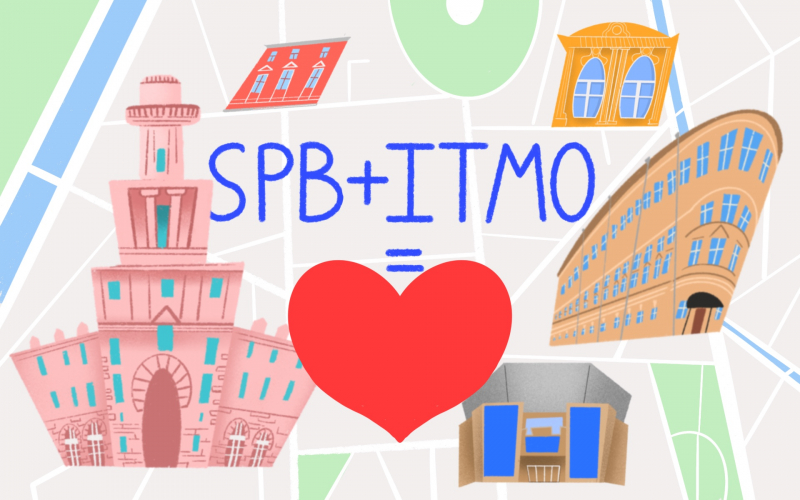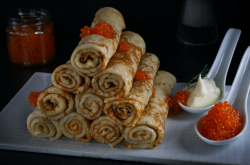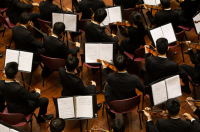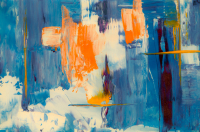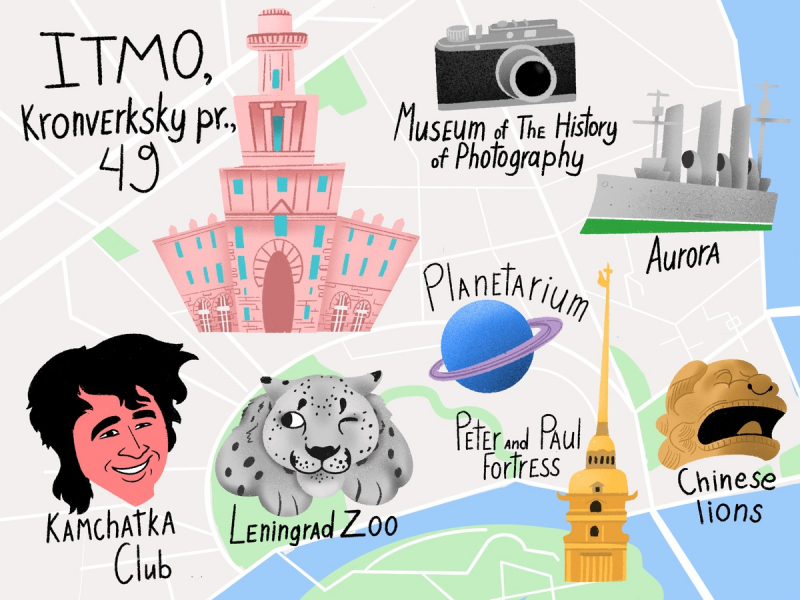
The Peter and Paul Fortress
The fortress was established on May 27, 1703 on Hare Island. The exact date is now considered as the city’s birthday. The building consists of a number of bastions, the most famous is the Naryshkin Bastion. Since 1731, the St. Andrew's flag was raised there, and since 1865 a 12 o’clock cannon shot was fired. And there is also the Saint Petersburg Mint that has been operating for over 300 years. But for an ITMO student, the main thing to remember is: for several years, it has been at the walls of the Peter and Paul Fortress that university graduates have been receiving their long-awaited degrees.
The Planetarium
Here, you can watch the stars, take a virtual intergalactic flight, visit an observatory, a laboratory of entertaining experiments or a hall of illusions, and understand all the delights of a panoramic view of the ocean floor or an ice continent. Moreover, the Planetarium has a “horizon” space, where meetings with scientists and film screenings about space are regularly held. It also hosts public astronomical observations.
The Leningrad Zoo
More than 900 animal species are represented in the Leningrad Zoo, this year it celebrates its 155th anniversary. Today, a snow leopard lives there – the symbol of ITMO University's sports club (we are sure you will get to know the Kronbars better soon). Here’s a fun fact: Viacheslav Kovalev, an ITMO graduate, in the 90s worked as the director of a concert hall at the Leningrad Zoo, where many rock musicians started their careers. For example, Diana Arbenina and Svetlana Surganova recorded their first albums there.
Chinese lions on the Petrovskaya Embankment
In St. Petersburg, you can find dozens of sculptures of lions and sphinxes. These animals are rightfully claimed to be the symbols of the city. Not far from ITMO University, you will find sculptures of Shih Tzu Chinese lions from Manchuria (in fact, these are mythical half-lion-half-frogs creatures), which were installed on the Petrovskaya Embankment in 1907.
Aurora
One of the city's most recognizable monuments is moored at the Petrogradskaya embankment. On October 25, 1917 a famous shot from its forecastle gun signaled the start of the assault on the Winter Palace, which was to be the beginning of the October Revolution.
Kamchatka Club
A legendary place in the heart of St. Petersburg, where Viktor Tsoi and Alexander Bashlachev worked as firemen. Today, it is both a museum, a music club, and a platform for young authors who want to perform their work. And since ITMO students are talented not only in science but also in art, we are giving you an idea of excellent venues.
The Museum of the History of Photography
This is a theater, an installation, and an attraction at the same time. Most of the photo exposition is made up of private collections. Interesting fact: ITMO University, as one of the oldest universities in the country, is also closely associated with photography. It was at ITMO University that they began to produce high-quality optical devices, including lenses for photographic devices.
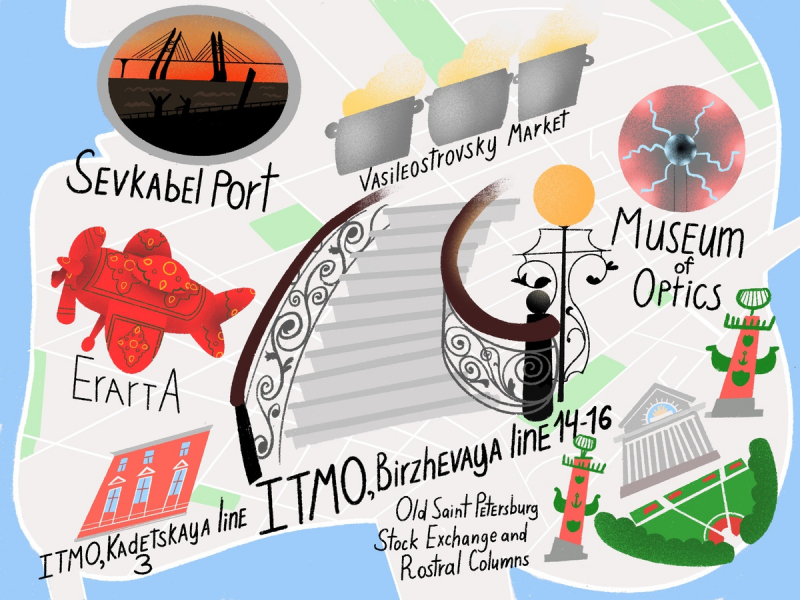
The Spit of Vasilyevsky Island and the Old Saint Petersburg Stock Exchange
According to Peter I’s plan, the Spit of Vasilievsky Island became the business center of the city. And the central place in its architectural ensemble went to the Stock Exchange. A beautiful view of the Neva river opens from the Spit, and two picturesque embankments – Universitetskaya and Makarova – diverge from Birzhevaya Square.
Rostral Columns
In Peter's times, the columns served as beacons for merchant ships that enter the port. It is no coincidence that the columns are decorated with the bows of the ships (rostra and anchors), and at their base, there are sculptures of the Volga, Dnieper, Volkhov, and Neva rivers.
The Museum of Optics
The first university-based interactive museum is located in the ITMO University building on Birzhevaya Line 14-16. The exposition includes 11 halls where you can get acquainted with the history of optics, learn about new technologies in this area, or even touch optical phenomena. Moreover, the museum hosts temporary installations, including those created in partnership with foreign university partners. If you want to prove to yourself that science is beautiful, you should definitely visit this museum.
Erarta
The largest private museum of contemporary art in Russia. It hosts exhibitions, guided tours, theater performances, concerts, and educational and scientific events. For example, for two years in a row, Erarta has become the site for the most non-classical scientific conference of ITMO University – ITMO Open Science. And there is also a magic carpet and much more.
Vasileostrovsky market
This is a new gastronomic market in St. Petersburg, which has already become one of the attraction points on Vasilyevsky Island. Here, you can buy any product: from expensive cheeses to your grandmother's homemade pickles, as well as enjoy already prepared food from different cuisines.
Sevkabel Port
It's a long way to go across the island, but it's worth it. Here, you can practice yoga, go skateboarding, drink coffee, eat burgers, listen to an open lecture, or just take a walk and enjoy the view of the bay. By the way, popular science events are also held here. For example, last year ITMO University held a Datathon on Texts Annotation in Sevkabel.
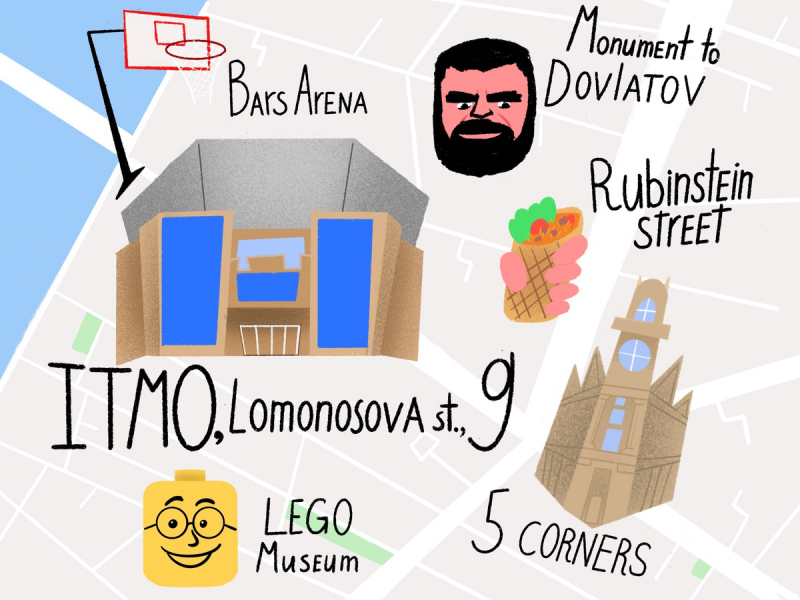
Five corners
The intersection of Zagorodny Prospekt, Rubinstein, Lomonosova, and Razyezhaya streets is a popular symbol of St. Petersburg. Famous people such as Fyodor Dostoevsky, Nikolai Rimsky-Korsakov, Mikhail Glinka, and Pyotr Tchaikovsky lived nearby. But it is the architecture that attracts your attention. It is impossible to pass by the famous Ioff's house with a turret. By the way, in the 1930s, the physicist Matvey Bronstein, who was engaged in questions of quantum theory and cosmology, lived there, too.
Rubinstein street
There are many bars, restaurants, and other establishments in St. Petersburg, but Rubinstein Street is a legendary place. Since the mid-2000s, it was there that a gastronomic boom took place: many bars, pizzerias, and diners appeared on Rubinstein Street, which conquered the hearts of the city's citizens. Thanks to its success, the street quickly became known as one of the city's main restaurant streets.
Monument to Dovlatov
Great artists also lived on Rubinstein street: from composer Anton Rubinstein to writer Sergei Dovlatov. In 2016, a sculptural composition dedicated to Dovlatov was installed there. Another point of attraction is located very close to Lomonosova St. 9.
Lego Museum
The POLEKON Museum features 14 palaces and castles, as well as the City of the Future, made from over a million LEGO bricks and pieces. By the way, ITMO University's school robotics team is also LEGO-friendly – last year, the team won silver medals at the World Robot Olympiad with the LEGO Education Helper project.
Bars Arena – a sports complex on Lomonosova St. 9.
This is a large sports complex with a shooting range, a gym, a wrestling hall for the martial arts section, a large playing hall with basketball hoops, volleyball racks with a net, and a small hall with a climbing frame and soft carpeting.
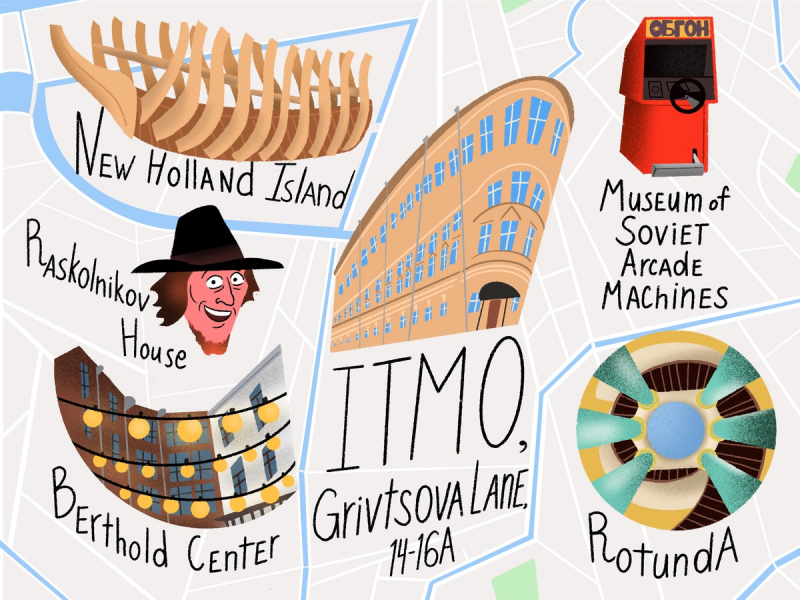
Berthold Center
The popular urban space is located in the buildings of the former Hermann Berthold Foundry, a factory that created hand-typed typefaces. Today, here you can find products of local brands, establishments with cuisine from different countries, including signature cuisine, sports grounds, and a roof with an excellent view. Moreover, the Сenter regularly hosts events and new residents appear.
Museum of Soviet arcade machines
The museum collection contains more than 50 operating Soviet arcade machines, which, as before, will allow you to enjoy the game for only 15 kopecks. Besides, various VKontakte and Geek picnic events are organized there, as well as science and pop events, including those of ITMO University. The museum also often hosts meetups of computer game developers.
Raskolnikov House
It is difficult to imagine St. Petersburg without Dostoevsky. The legendary book character, Rodion Raskolnikov, lived on Stolyarny Lane, 5. The building was not chosen by chance. Dostoevsky himself was a tenant of this apartment building. Over the years there, he wrote Crime and Punishment and The Gambler.
Rotunda
In the house on the corner of Gorokhovaya Street and the Fontanka Embankment, you can find a city object shrouded in mysticism – a house with a Rotunda. There are legends that St. Petersburg masons performed the initiation rite there – once the house belonged to the famous mason Andrey Zubov. Those who do not believe in the conspiracies of the masons should come here at least once to enjoy the excellent acoustics. In the 70s and 80s of the 20th century, rockers, hippies, and punks gathered here. The rotunda was repeatedly visited by Kinchev and Tsoi, and for many, that is why it has become a landmark place.
New Holland Island
Another popular urban space with local shops, restaurants, a variety of food and drinks, and an amazing park for a walk. Open lectures are hosted there, including those on popular science topics, film screenings and concerts, and a number of other events are also held there.
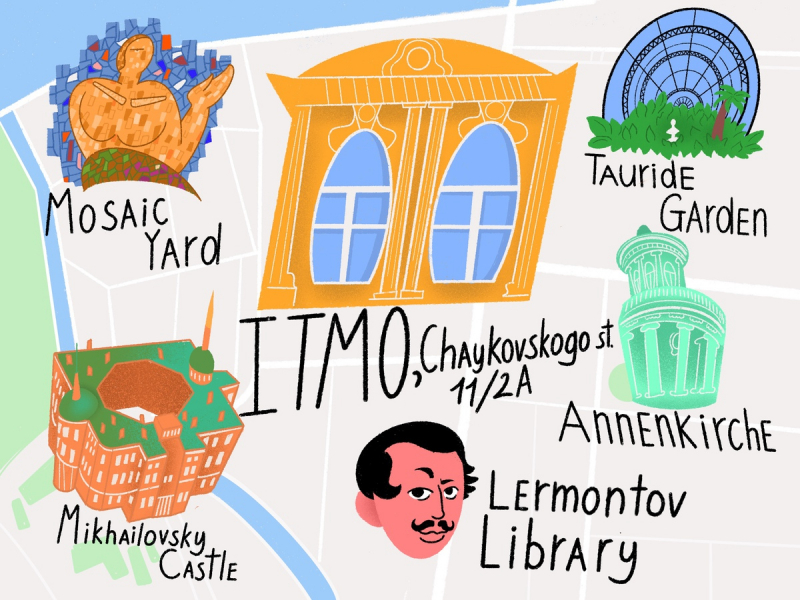
The Mosaic Yard
The mosaic composition hidden in one of the courtyards-wells at Chaykovskogo Street is a creative laboratory of Vladimir Lubenko. Artists and students of the Small Academy of Arts turned an unremarkable space into a colorful fairy world. Be sure to visit the mosaic courtyard to experience the contrast between the landscapes of the overcast city and the stained glass paintings.
The Greenhouse of the Tauride Garden and the Tauride Garden
The greenhouse is a beautiful green corner in the city center with its cafes and a flower shop. It hosts concerts, master classes, creative evenings, and other events. The greenhouse building is adjacent to the territory of the Tauride Garden, which was built at the end of the 18th century. Today, it is a picturesque park with a pond where swans live. Open workshops are regularly held in the garden, musicians are playing, and the most pleasant thing is to just sit by the water with friends or read your favorite book on the green grass.
The Mikhailovsky castle
Castle-fortress of Paul I, in which the emperor was destined to live only 40 days. Back then, it was a monument to manic mistrust and fear of persecution: the moat and drawbridges are left reminders. After the death of Paul I, the building housed an engineering school (hence the second name – the Engineers' Castle), and in 1991 the castle became part of the State Russian Museum. It now houses the permanent exhibition of the art gallery.
Annenkirche
The Lutheran Church of the 18th century, which in 1939 became the Soviet cinema "Spartak", from 1992 to 1997 was part church, part rock club, and in the early 2000s, it regained its church status. In 2002, there was a huge fire in Annenkirche, only by 2010 the facade of the building was restored, and the interiors remained damaged. Today, concerts, exhibitions, fairs, film screenings and many, many other interesting events are held here (and you can also hear the organ in Annenkirche).
Lermontov Library
A large library and also an open lecture hall, where entertaining popular science lectures, master classes, game presentations, film screenings, exhibitions of contemporary St. Petersburg artists and photographers are regularly held.
ITMO News Editorial Team
